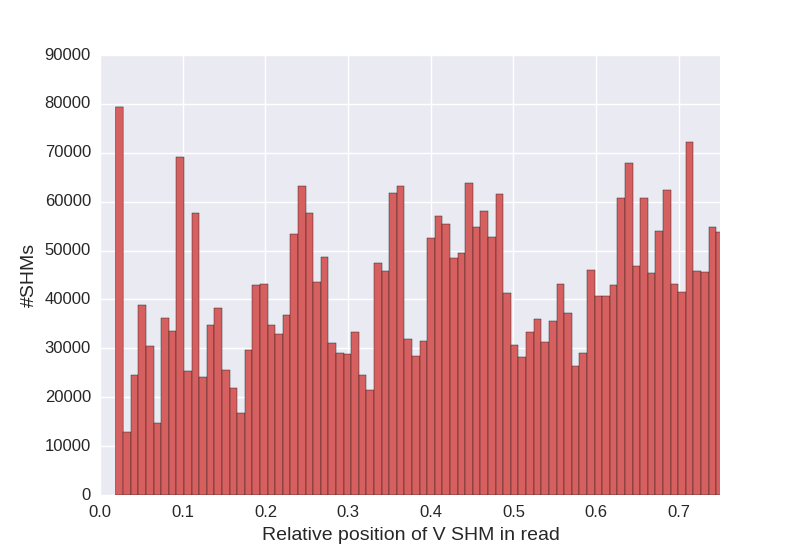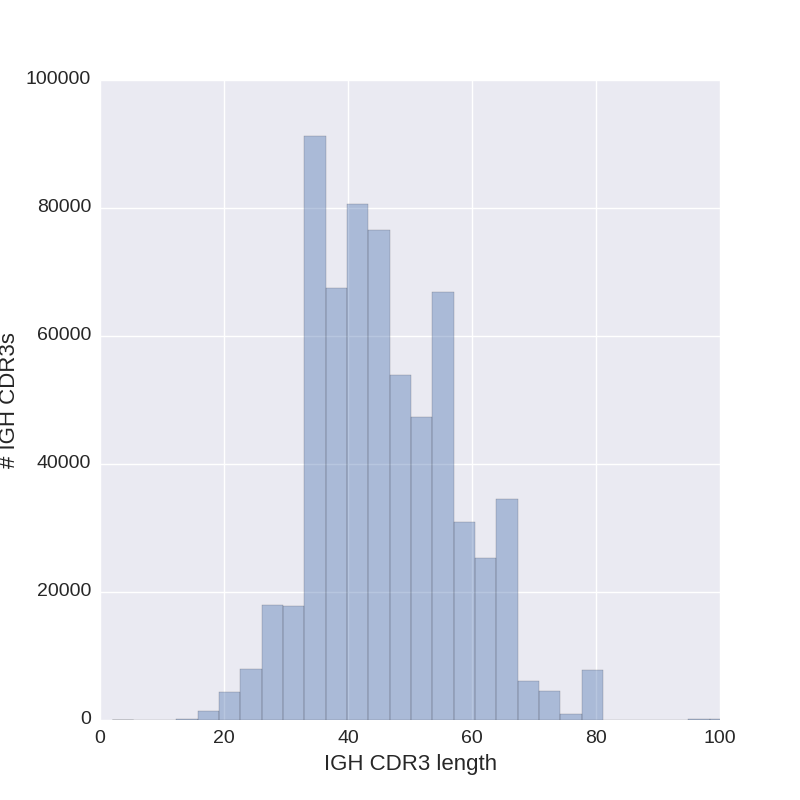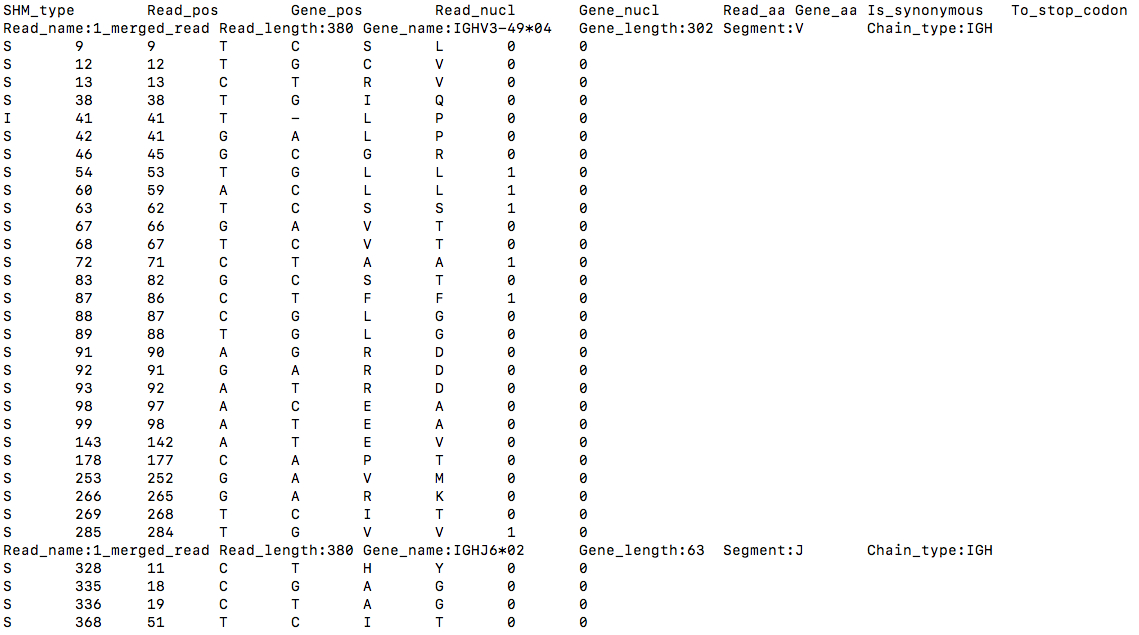Introduction
Diversity Analyzer is a tool for annotation and diversity analysis of full-length adaptive immune repertoires (antibodies or TCRs). Diversity Analyzer is launched as a final step of IgReC. It is also available as a stand alone tool.
Input
Diversity Analyzer takes full-length immune sequences in FASTA/FASTQ format as an input. The tool expects that input sequences cover entire variable regions of antibody or TCR: from the start of V segment to the end of J segment. The tool is able to process raw Rep-seq libraries, as well as constructed repertoires.
Output
Diversity Analyzer performs V / J, CDR, and SHM labelings of input sequences; computes their diversity characteristics; computes nucleotide and amino acid substitutions; visualizes computed statistics and reports summary in user-friendly HTML format.
Output details
- Summary report
- VJ labeling output
- CDR labeling output
- SHM labeling output
- Diversity statistics
- Nucleotide and amino acid substitutions
- Summary annotation report
1. Summary report
Diversity Analyzer compiles a report in TSV format including basic diversity characteristics of input sequences. For each input sequence, report contains information about:
- Chain type: IGH / IGK / IGL / TRA / TRB / TRG / TRD.
- V and J hits. Gene names are consistent with IMGT database.
- Amino acid sequence.
- Information about productiveness: presence of stop codon (1 or 0); in-frame (1 or 0); productive (1 or 0).
- Positions of CDR1, CDR2, and CDR3. Note that all positions are inclusive.
2. VJ labeling output
Diversity Analyzer launches VJ Finder (ultra-fast aligner of Rep-seq reads) for finding V and J hits of input sequences.
Based on computed VJ labeling, DiversityAnalyzer reports heatmap showing VJ usage:
2.1. V alignments
Diversity Analyzer reports all computed V alignments in FASTA file. Each alignment is presented as a pair of gapped sequences of equal length. Code below shows an example of V alignments in FASTA format for a single read-gene pair:
>INDEX:1|READ:1_merged_read|START_POS:0|END_POS:295
GAGGTGCAGTTGGTAGAGTCTGGGGGAGGATTGGTCCAGCCGGGGGGGTCCCTGAGACTCTCCTGTGCAGCCTCTGGATTCACCTTTAGTAGTTATTGGATGAGCTGGGTCC
GCCAGGCTCCAGGGAAGGGGCTGGAGTGGGTGGCCAACATAAAGCAAGATGAAAGTGAGAAATATTATGTGGACTCTGTGAAGGGCCGATTCACCATCTCCAGAGACAACGC
CAAGAAGTCACTGTCTCTGCGAACGAACAGGCTGAGAGCCGAGTACATGGCTGTGTATTACTGTGCGAGTAC
>INDEX:1|GENE:IGHV3-7*01|START_POS:0|END_POS:295|CHAIN_TYPE:IGH
GAGGTGCAGCTGGTGGAGTCTGGGGGAGGCTTGGTCCAGCCTGGGGGGTCCCTGAGACTCTCCTGTGCAGCCTCTGGATTCACCTTTAGTAGCTATTGGATGAGCTGGGTCC
GCCAGGCTCCAGGGAAGGGGCTGGAGTGGGTGGCCAACATAAAGCAAGATGGAAGTGAGAAATACTATGTGGACTCTGTGAAGGGCCGATTCACCATCTCCAGAGACAACGC
CAAGAACTCACTGTATCTGCAAATGAACAGCCTGAGAGCCGAGGACACGGCTGTGTATTACTGTGCGAGAGA
3. CDR labeling output
Diversity Analyzer aligns input sequences against V and J segments from the IMGT database with known positions of CDRs
(positions are consistent with IgBlast).
Using alignment, positions of germline CDRs are converted into positions of input full-length sequences:
 IMGT and
Kabat notations are available for labeling.
Diversity Analyzer also reports computed CDR1s, CDR2s, and CDR3s in FASTA format.
IMGT and
Kabat notations are available for labeling.
Diversity Analyzer also reports computed CDR1s, CDR2s, and CDR3s in FASTA format.
3.1. CDR statistics
If a chain is presented by at least 100 input sequences, Diversity Analyzer computes characteristics of its CDRs:
|
Upper right: distribution of CDR3 lengths.
Diversity Analyzer also selects length of CDR3s that presented by the largest number of CDR3s.
For CDR3s of this length, nucleotide (lower left) and amino acid (lower right) content are visualized.
Amino acids are colored according to their hydrophobicity.
Hydrophobic amino acids are colored in red, hydrophilic amino acids are colored in blue,
neutral amino acids are colored in pale colors.
|
|
4. SHM labeling output
For each input sequence, Diversity Analyzer computes SHMs and compiles their characteristics in TSV format. For each SHM, the following characteristics are reported:
- SHM type: substitution (S) / insertion (I) / deletion (D).
- Positions on sequence and germline gene.
- Nucleotides of sequence and germline gene at the position of SHM. In case of indel, SHM is denoted as '–'.
- Amino acids of sequence and germline gene at the position of SHM.
- Indicator of SHM synonymy: 1 or 0.
- Indicator whether SHM leads to occurrence of stop codon: 1 or 0.
4.1 SHM plots
If a chain presented by at least 100 sequences, Diversity Analyzer reports plots for SHMs lying in V segments of sequences of this chain type:
| IGH | IGK | IGL |
 Click for preview
Click for preview
|
 Click for preview
Click for preview
|
 Click for preview
Click for preview
|
Diversity Analyzer also reports statistics of special SHMs lying in V segments:
| Distribution of indel SHMs positions | Distribution of indel SHMs lengths | Distribution of synonymous SHMs positions |
 Click for preview |
 Click for preview |
 Click for preview |
5. Diversity statistics
For each computed CDR3, Diversity Analyzer computes its abundance as a number of input sequences with this CDR3. For a collection of CDR3 abundances, Diversity Analyzer applies methods of population analysis for computation of diversity characteristics of input sequences.
| Simpson index (SI) | Clonal Simpson index (CSI) |
| SI is computed as a probability of two randomly selected CDR3s to be equal. | CSI is an approximation of a probability of two randomly selected CDR3s to belong to the same clonal lineage. |
A ratio of CSI to SI demonstrates relation between clonally related receptor sequences to random sequences. The higher value of CSI / SI, the higher clonal diversity of an input dataset. Example of the comparative analysis of three datasets with various properties is given below:
| PBMCs | ASCs (negative to influenza HA) | ASCs (positive to influenza HA) |
| 0-th day of vaccination | 7-th day of vaccination | 7-th day of vaccination |
| SRR3620098 | SRR3620075 | SRR3620074 |
| Low clonal diversity | Medium clonal diversity | High clonal diversity |
| CSI / SI = 1.36 | CSI / SI = 7.15 | CSI / SI = 11.96 |
6. Amino acid and nucleotide substitutions
Diversity Analyzer reports and visualizes matrices of nucleotide and amino acid substitutions:
 Click for preview
Click for preview
|
 Click for preview
Click for preview
|
7. Summary annotation report
Diversity Analyzer compiles all computed statistics and plots into a single report in HTML format. Example of such report can be found here (antibody repertoire from HIV-infected patient, 181 week of disease).

 Click for preview
Click for preview
 Click for preview
Click for preview
 Click for preview
Click for preview
